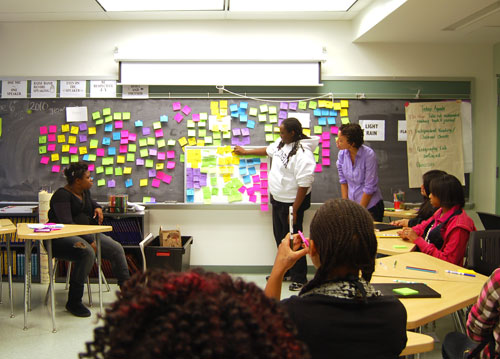The advantage of using intelligent tutoring applications in some cases is that it provides students with additional support and feedback the moment it is needed, something that is difficult for teachers to provide to students in large classrooms. With the increase in use of smartphones and other mobile devices such as the iPad, there is a good chance that this sort of technology will be used to support learning anywhere, anytime.
Although most intelligent tutoring systems are geared for 1-1 computing, I think there are some components that could be tweaked and then transfered to create intelligent "tutoring" systems for collaborative learning. Students like game-based learning, and what could be more fun than playing AND learning with a partner or group of peers? (I plan to revisit the research in this area in an upcoming post.)
There are a few applications developed for collaborative learning activities around a multi-touch table, such as the SMARTTable or the Surface, and more are needed. Also needed are intelligent systems that can support video conferencing and collaborative learning between students who are not physically co-located.
There are some problems that have yet to be solved. For example, the use of multiple sensors for an application designed for young people might be too intrusive. There are serious issues related to privacy/security. Who would have access to data regarding a student's emotional or physiological state? How would this data be utilized? How would this information be protected? Many school districts have security vulnerabilities, so it is possible that this information could be misused, if in the wrong hands.
ClassmateAssist is an application developed by Intel's Everyday Sensing and Perception team. Here is the description of the application from Intel Research:
Intel Research: Everyday Sensing and Perception
Socially and Physically Aware Interaction Systems (SPAIS)
Intel Research Press kit
SPAIS Publications:
Theocharous, G., Beckwith, R., Butko, N., Philipose, M. Tractable POMDP Planning Algorithms for Optimal Teaching in "SPAIS". International Joint Conferene on Artificial Intelligence (IJCAI) workshop on Plan Activity, and Intent Recognition (PAIR), Pasadena, California, July 2009.
Theocharous, G., Butko, N., Philipose, M. Designing a Mathematical Manipulatives Tutoring System using POMDPS. (pdf). POMDP Practitioners Workshop: Solving Real-world POMDP Problems, International Conference on Automated Planning and Scheduling (ICAPS). Toronto, May 2010
Wayang Outpost: Web-based Interactive Math/Intelligent Tutoring System, with Sensors.
I've followed the work of Beverly P. Woolf and her colleagues for some time. Much of their research has centered around a web-based application, Wayang Outpost, an intelligent electronic tutoring system that incorporates multimedia and animated adventures while providing activities designed to prepare teens for standardized math tests, such as the SAT and state-mandated end-of-course exams.
In recent years, the team has been using non-invasive sensors in their research, including a camera that views facial expressions, a posture-sensing device located in the seat of the student's chair, and a pressure-sensitive mouse, and a wireless skin conductance wristband. Data collected through all of these sensors can provide useful information about student learning. The system can also note when students try to "game" the system.
Related Publications
Woolf, B.P., Arroyo, I., Muldner, K., Burleson, W., Cooper, D., Dolan, R., Christopherson, R.M (2010)The Effect of Motivational Learning Companions on Low Achieving Students and Students with Disabilties (pdf) International Conference on Intelligent Tutoring Systems, Pittsburgh.
Abstract "We report the results of a randomized controlled evaluation of the effectiveness of pedagogical agents as providers of affective feedback. These digital learning companion were embedded in an intelligent tutoring system for mathematics, and were used by approximately one hundred students in two public high schools. Students in the control group did not receive the learning companions. Results indicate that low-achieving students—one third of whom have learning disabilities—had higher affective needs than their higher achieving peers; they initially considered math problem-solving more frustrating, less exciting, and felt more anxious when solving math problems. However, after they interacted with affective pedagogical agents, low-achieving students improved their affective outcomes, e.g., reported reduced frustration and anxiety."
Arroyo, I., Cooper, D.G., Burleson, W., Woolf, B.P., Muldner, K., Christopherson, R. (2009)
Emotion Sensors Go To School. AIED 2009. Pp. 17-24. IOS Press.
Low-tech description of Wayang Outpost, the math application used in the above publication:
Paul Franz, Recoder.Com 5/16/09
Cooper, D.G., Arroyo, I., Woolf, B.P., Muldner, K., Burleson, W., Christoperson, R. Sensors Model Student Self-Concept in the Classroom (pdf) UMass Amherst, June 22, 2009/UMAP 2009





































